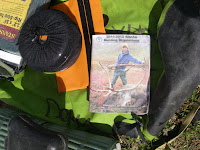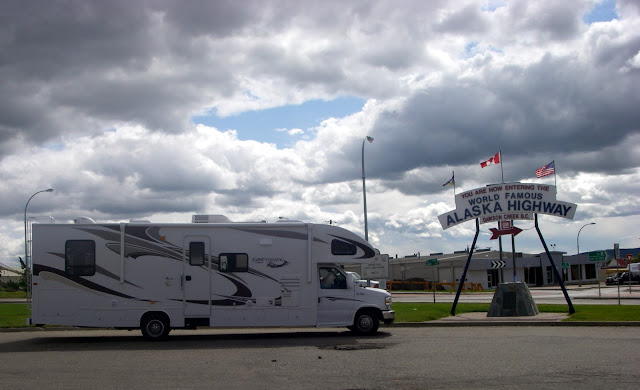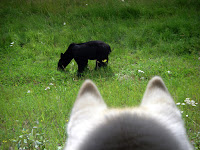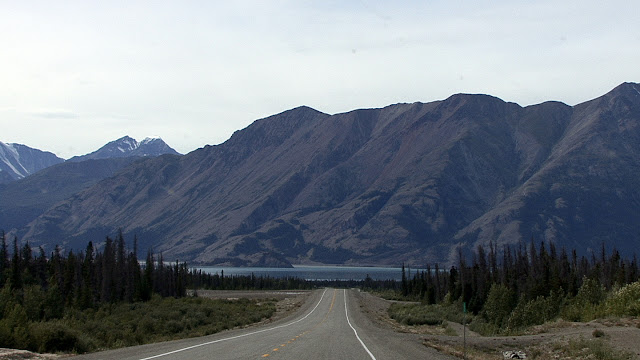On August 15th, with Carlisle's truck loaded, Bucky and I headed to Fairbanks under blue skies with Denali leading us North. Fairbanks is a 278 mile drive on the Parks Highway, named for George Parks, former territorial governor. It is not named for Denali National Park. The Parks Highway is both beautiful and terrifying with a speed limit of 65 and most vehicles traveling well above this. It is my perception that Alaskan drivers are perhaps the most erratic and unpredictable of any I have encountered. Combine this with the occasional moose stepping into the highway and it creates some heart stopping moments. However, our arrival in Fairbanks was uneventful. We arranged to have new tires put on the truck early the following morning and visited Fred Mhyer, the best all purpose grocery in Alaska for our last minute necessities such as Benedryl, tonic and lime. That night we slept in the driveway of Carlisle's friend Molly and caught up with her about her courses at the University of Alaska, met her new sled dog Lindsey and maveled at her friend's dog "Rob". Maggie's two sled dogs plus Rob were hitched to houses on the side of the drive in puddles of mud. Evidently, Fairbanks which is usually hot and dry, had experienced a rainy summer.
 |
| Denali, our guide. |
Sled dogs in Alaska are a dime a dozen and many folks have at least that many. Molly inherited her first dog Maggie as an abandoned dying puppy during our 2009 visit. Her next dog, Lindsey, came along a year later to keep Maggie company. Alaskan sled dogs are mutts of all colors, shapes and sizes. Both Maggie and Lindsey have maintained some resemblance to their Husky heritage having long snouts, pointed ears and black masks. Rob also seemed to have inherited the traits of both breeds from which he came, Golden Retriever and Husky. While his front half was smiling in the loyal way of a Golden, with ears flopping and a desire to be petted, head lying on your lap, his rear half looked distant and uninterested, turning away from his head and looking for escape. As Bucky said, it was a pure case of not knowing whether he was coming or going. His inherited desires seemed to play havoc with his emotions making him one of the strangest dogs I have ever met.
 |
| our bed |
The following morning we arrived at the tire store bright and early. We were met by Phyllis. As I have said before, it isn't just the scenery but the people we meet who define the adventure. Pert and pleasant, Phyllis rattled off tire sizes and numbers indicating years of having dealt with rubber. While Bucky shopped tires, I looked at the old log homes tucked within the modern city of Fairbanks. When I asked Phyllis about the well kept home next to the garage, she responded that it was hers, one of the oldest in Fairbanks, 1911.
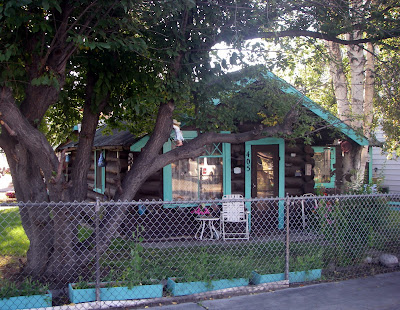 |
| Phyllis' house |
With new rubber, we headed confidently out of Fairbanks onto the Elliot Highway leading us into the beautiful White Mountains and eventally onto the Dalton Highway, a distance of 84 miles. Shortly outside of Fairbanks cell service is lost, as is pavement and services of most kinds.
On August 16th, at mile 115.5, we crossed the Arctic Circle, latitude 66. At his latitude, the sun doesn't set on the summer solstice and does not rise on the winter solstice. A third of Alaska lies within the Arctic Circle.
Like most travelers of the Dalton Highway, we slept in pull-offs and gravel pits along the way. No advanced reservations are needed, but sometimes you're not alone.
August 17th, we pulled into the Trucker's Cafe at Coldfoot Camp, mile 175 of the Dalton. Fans of the TV show, Ice Road Truckers, know this as the last stop for truckers heading to Deadhorse with their huge over sized loads. Here there is lodging, fuel and tire repair. It is hundreds of miles before these are again available.
 |
| Coldfoot Camp |
The trucks were both fascinating and annoying. Their purpose was undisputable and all other traffic made way for their passage. At times the dust was overwhelming.
 |
After eating a trucker sized breakfast in Coldfoot and using the payphone to let Carlisle know of our whereabouts, we traveled on, taking a short detour across the Koyukuk River at mile 188, into the historic mining town of Wiseman. It was here that we met "Clutch" Lounsbury, former Alaska Highway employee and gold miner. He wandered out of his cabin when he saw us arrive and invited us into his mining museum. The museum was his tribute to his long time mining partner who had since passed away. The stories of lost gold nuggets, playing competitive ice hockey and Ice Road rescues kept us entertained.
 |
| Clutch's house |
Historic Wiseman
We followed the oil pipeline in and out of the spruces until seeing the "last spruce" at mile 235, now killed by vandals, but still standing. There now seems to be a last spruce a little further to the north.....climate warming??? At mile 244, we headed up the famous Atigun Pass, through the Brooks Range. This pass dumped us out on the North Slope. Here we encountered our first herd of Dall Sheep licking the calcium chloride used on the highway for dust control.
On August 17, mile 318 became our home for the next 8 days.
To be continued....











